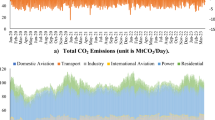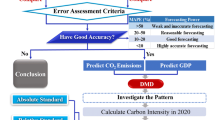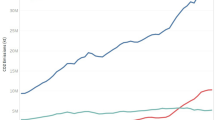Abstract
CO2 emissions have contributed to global warming and belong to high-noise, non-stationary and nonlinear systems. An accurate prediction method for annual CO2 emissions can improve the effectiveness of emission reduction policies. However, the existing prediction methods for small-scaled samples (i.e., hourly or daily time series) are unsuitable for regional policy benchmarks. Hence, a novel hybrid prediction model under data decomposition mode is developed for annual CO2 emissions in this work. For illustration, the five representative CO2 emissions (i.e., China, United States, India, Russian, and Japan) from 1970 to 2019 are collected to verify performance, which are taken from Global Carbon Project. The results show that the average prediction accuracy of the proposed prediction model is up to 97.95%, which whole performance improved by more than 1.61% compared with others. The total of five countries’ annual CO2 emissions in 2020 (18,311.72 metric tons) is approximately equal to that in 2018 (18,353.63 metric tons). The proposed model is a reliable prediction tool for annual CO2 emissions and can assist policymakers in adjusting reduction measures and regulators to access the current effects.








Similar content being viewed by others
References
Bokde, N. D., Tranberg, B., & Andresen, G. B. (2020). Short-term CO2 emissions forecasting based on decomposition approaches and its impact on electricity market scheduling. Applied Energy, 281, 116061.
Chen, J., Xu, C., Cui, L., Huang, S., & Song, M. (2018). Driving factors of CO2 emissions and inequality characteristics in china: A combined decomposition approach. Energy Economics, 78(Feb), 589–597.
Chen, Y., Xie, X., Zhang, T., Bai, J., & Hou, M. (2020). A deep residual compensation extreme learning machine and applications. Journal of Forecasting, 39(6), 1–25.
Colominas, M. A., Schlotthauer, G., & Torres, M. E. (2014). Improved complete ensemble emd: A suitable tool for biomedical signal processing. Biomedical Signal Processing & Control, 14, 19–29.
Cui, C., Wang, Z., Cai, B., Peng, S., & Xu, C. (2021). Evolution-based CO2 emission baseline scenarios of Chinese cities in 2025. Applied Energy, 281, 116116.
Deng, J. L. (1982). Control problems of grey systems. Systems & Control Letters, 1(5), 288–294.
Fang, Y., Guan, B., Wu, S., & Heravi, S. (2020). Optimal forecast combination based on ensemble empirical mode decomposition for agricultural commodity futures prices. Journal of Forecasting, 29(3), 1–16.
Gulay, E., & Duru, O. (2020). Hybrid modeling in the predictive analytics of energy systems and prices. Applied Energy, 268, 114985.
Huang, J., Xiao, Q., Liu, J., & Wang, H. (2019). Modeling heat transfer properties in an ORC direct contact evaporator using RBF neural network combined with EMD. Energy, 173, 306–316.
Huang, N. E., Shen, Z., Long, S. R., Wu, M. C., Shih, H. H., Zheng, Q., Yen, N. C., Tung, C. C., & Liu, H. H. (1998). The empirical mode decomposition and the Hilbert spectrum for nonlinear and non-stationary time series analysis. Proceedings Mathematical Physical & Engineering Sciences, 454(1971), 903–995.
International Energy Agency. (2019). Global Energy & CO2 Status Report 2019.
Kardani, M. N., Baghban, A., Sasanipour, J., Mohammadi, A. H., & Habibzadeh, S. (2018). Group contribution methods for estimating CO2 absorption capacities of imidazolium and ammonium-based polyionic liquids. Journal of Cleaner Production, 203, 601–618.
Karthikeyan, L., & Nagesh Kumar, D. (2013). Predictability of non-stationary time series using wavelet and EMD based ARMA models. Journal of Hydrology, 502, 103–119.
Kumar, S., Managi, S., & Jain, K. J. (2020). CO2 mitigation policy for Indian thermal power sector: Potential gains from emission trading. Energy Economics, 86, 104653.
Li, K., & Zhang, T. (2019). A novel grey forecasting model and its application in forecasting the energy consumption in shanghai. Energy Systems, 3, 1–16.
Lin, C. S., Liou, F. M., & Huang, C. P. (2011). Grey forecasting model for CO2 emissions: A Taiwan study. Applied Energy, 88(11), 3816–3820.
Liu, D., & Sun, K. (2019). Short-term PM2.5 forecasting based on CEEMD-RF in five cities of China. Environmental Science and Pollution Research, 26, 32790–32803.
Liu, S., & Xiao, Q. (2021). An empirical analysis on spatial correlation investigation of industrial carbon emissions using SNA-ICE model. Energy, 224, 120183.
Liu, Z., Jiang, P., Zhang, L., & Niu, X. (2020). A combined forecasting model for time series: application to short-term wind speed forecasting. Applied Energy, 259, 114137.1-114137.25.
Mcmullin, B., Price, P., Jones, M. B., & Mcgeever, A. H. (2020). Assessing negative carbon dioxide emissions from the perspective of a national “fair share” of the remaining global carbon budget. Mitigation and Adaptation Strategies for Global Change, 25, 579–602.
Nazir, H. M., Hussain, I., Ahmad, I., Faisal, M., & Almanjahie, I. M. (2019). An improved framework to predict river flow time series data. PeerJ, 7, 1–22.
Pao, H. T., Fu, H. C., & Tseng, C. L. (2012). Forecasting of CO2 emissions, energy consumption and economic growth in china using an improved grey model. Energy, 40(1), 400–409.
Paschalidou, A. K., Karakitsios, S., Kleanthous, S., & Kassomenos, P. A. (2011). Forecasting hourly PM10 concentration in cyprus through artificial neural networks and multiple regression models: Implications to local environmental management. Environmental Science and Pollution Research International, 18(2), 316–327.
Qin, Q., He, H., Li, L., & He, L. (2020). A novel decomposition-ensemble based carbon price forecasting model integrated with local polynomial prediction. Computational Economics, 55, 1249–1273.
Risse, M. (2019). Combining wavelet decomposition with machine learning to forecast gold returns. International Journal of Forecasting, 35(2), 601–615.
Sen, P., Roy, M., & Pal, P. (2016). Application of ARIMA for forecasting energy consumption and GHG emission: A case study of an Indian pig iron manufacturing organization. Energy, 116, 1031–1038.
Shakun, J. D., Clark, P. U., He, F., Marcott, S. A., Mix, A. C., Liu, Z., Bliesner, B. O., Schmittner, A., & Bard, E. (2012). Global warming preceded by increasing carbon dioxide concentrations during the last deglaciation. Nature, 484(7392), 49–54.
Sun, W., & Liu, M. (2016). Prediction and analysis of the three major industries and residential consumption CO2 emissions based on least squares support vector machine in China. Journal of Cleaner Production, 122, 144–153.
Tien, T. L. (2009). A new grey prediction model FGM (1, 1). Mathematical & Computer Modelling, 49, 1416–1426.
Torres, M. E., Colominas, M. A., Schlotthauer, G., Flandrin, P. (2011). A complete ensemble empirical mode decomposition with adaptive noise, in IEEE international conference on acoustics, pp. 4144–4147.
Wang, D., Liu, X., Yang, X., Zhang, Z., Wen, X., & Zhao, Y. (2021). China’s energy transition policy expectation and its CO2 emission reduction effect assessment. Frontiers in Energy Research, 8, 627096.
Wang, J. Z., Bai, L., Wang, S. Q., & Wang, C. (2019a). Research and application of the hybrid forecasting model based on secondary denoising and multi-objective optimization for air pollution early warning system. Journal of Cleaner Production, 234, 54–70.
Wang, J., Yang, F., & Chen, K. (2019b). Regional carbon emission evolution mechanism and its prediction approach: A case study of Hebei. China. Environmental Science and Pollution Research, 26(11), 28884–28897.
Wei, S., Yuwei, W., & Chongchong, Z. (2018). Forecasting CO2 emissions in hebei, china, through moth-flame optimization based on the random forest and extreme learning machine. Environmental Science and Pollution Research, 25, 28985–28997.
Wen, L., & Yuan, X. (2020). Forecasting CO2 emissions in chinas commercial department, through bp neural network based on random forest and PSO. The Science of the Total Environment, 718, 137194.1-137194.14.
Wu, L., Liu, S., Liu, D., Fang, Z., & Xu, H. (2015). Modelling and forecasting CO2 emissions in the BRICS (Brazil, Russia, India, China, and South Africa) countries using a novel multi-variable grey model. Energy, 79(79), 489–495.
Wu, L., Liu, S., Yao, L., & Yan, S. (2013). The effect of sample size on the grey system model. Applied Mathematical Modelling, 37(9), 6577–6583.
Wu, Q., & Lin, H. (2019). A novel optimal-hybrid model for daily air quality index prediction considering air pollutant factors. Science of the Total Environment, 683, 808–821.
Wu, Z. H., & Huang, N. E. (2009). Ensemble empirical mode decomposition: A noise-assisted data analysis method. Advances in Adaptive Data Analysis, 1, 1–41.
Wu, Z., Zhao, X., Ma, Y., & Zhao, X. (2019). A hybrid model based on modified multi-objective cuckoo search algorithm for short-term load forecasting. Applied Energy, 237, 896–909.
Xiao, L., Qian, F., & Shao, W. (2017). Multi-step wind speed forecasting based on a hybrid forecasting architecture and an improved bat algorithm. Energy Conversion and Management, 143, 410–430.
Yang, S., Wang, Y., Ao, W., Bai, Y., & Li, C. (2018). Prediction and analysis of CO2 emission in chongqing for the protection of environment and public health. International Journal of Environmental Research & Public Health, 15(3), 530–545.
Zhao, X., Ma, X., Chen, B., Shang, Y., & Song, M. (2022). Challenges toward carbon neutrality in China: Strategies and countermeasures. Resources, Conservation and Recycling, 176, 105959.
Zhou, M., Zeng, B., & Zhou, W. (2020a). A hybrid grey prediction model for small oscillation sequence based on information decomposition. Complexity, 2020(3), 1–13.
Zhou, X., Guan, X., Zhang, M., Zhou, Y., & Zhou, M. (2020b). Allocation and simulation study of carbon emission quotas among China’s provinces in 2020. Environmental Science and Pollution Research, 24, 7088–7113.
Zhu, B., Wang, P., Chevallier, J., & Wei, Y. (2015). Carbon price analysis using empirical mode decomposition. Computational Economics, 45, 195–206.
Acknowledgements
The authors thank the anonymous reviewers for their valuable comments, which helped us considerably improve this paper’s content, quality, and presentation.
Funding
This work was financially supported by Interdisciplinary Research Project of Kunming University of Science and Technology (No. KUST-xk2022001), Yunnan Fundamental Research Project (No. 202201BE070001-026), Natural Science Foundation of Yunnan Province (No. 202101AU070031), Young Talent Training Program for Science and Technology Think Tank by China Association for Science and Technology (No. 20220615ZZ07110003) and Young Elite Scientist Sponsorship Program by China Association for Science and Technology (No. YESS20210106).
Author information
Authors and Affiliations
Contributions
All authors contributed to the study conception and design. Dr. QX proposed conceptualization. The software was written by Mr. YW and Mr. ZS. Material preparation, data collection, and analysis were performed by Miss. PY. The first draft of the manuscript was written by Mr. YW, and the review and editing of the manuscript by Dr. QX and Dr. JC. All authors read and approved the final manuscript.
Corresponding author
Ethics declarations
Conflicts of interest
The authors have no conflicts of interest to declare that are relevant to the content of this article.
Additional information
Publisher's Note
Springer Nature remains neutral with regard to jurisdictional claims in published maps and institutional affiliations.
Rights and permissions
Springer Nature or its licensor (e.g. a society or other partner) holds exclusive rights to this article under a publishing agreement with the author(s) or other rightsholder(s); author self-archiving of the accepted manuscript version of this article is solely governed by the terms of such publishing agreement and applicable law.
About this article
Cite this article
Wang, Y., Yang, P., Song, Z. et al. Intelligent Prediction of Annual CO2 Emissions Under Data Decomposition Mode. Comput Econ 63, 711–740 (2024). https://doi.org/10.1007/s10614-023-10357-8
Accepted:
Published:
Issue Date:
DOI: https://doi.org/10.1007/s10614-023-10357-8




